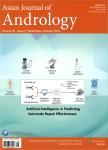Performance of the Prostate Health Index in predicting prostate biopsy outcomes among men with a negative digital rectal examination and transrectal ultrasonography
Performance of the Prostate Health Index in predicting prostate biopsy outcomes among men with a negative digital rectal examination and transrectal ultrasonography作者机构:Fudan Institute of Urology Huashan Hospital Fudan University Shanghai China Department of Urology Huashan Hospital Fudan University Shanghai China Department of Urology Fudan University Shanghai Cancer Center and Department of Oncology Shanghai Medical College Fudan University Shanghai China Department of Urology Xinhua Hospital School of Medicine Shanghai Jiao Tong University Shanghai China State Key Laboratory of Genetic Engineering School of Life Salience Fudan University Shanghai China Center for Cancer Genomics Wake Forest School of Medicine Winston-Salem North Carolina USA Department of Urology Shanghai Changhai Hospital Second Military Medical University Shanghai China Program for Personalized Cancer Care NorthShore University HealthSystem Evanston IL USA.
出 版 物:《Asian Journal of Andrology》 (亚洲男性学杂志(英文版))
年 卷 期:2016年第18卷第4期
页 面:633-638页
核心收录:
学科分类:0710[理学-生物学] 07[理学] 0905[农学-畜牧学] 08[工学] 09[农学] 071007[理学-遗传学] 0901[农学-作物学] 090501[农学-动物遗传育种与繁殖] 0836[工学-生物工程] 090102[农学-作物遗传育种]
基 金:We would like to thank all the study participants urologists and study coordinators for participating in the study. This work was partially funded by the National Key Basic Research Program Grant 973 (2012CB518301) the Key Project of the National Natural Science Foundation of China (81130047) National Natural Science Foundation of China (81202001 81272835) China Scholarship Council (CSC) intramural grants from Fudan University and Huashan Hospital and a research grant from Beckman Coulter Inc
主 题:[-2]proPSA prostate cancer Prostate Health Index prostate-specific antigen receiver operating curve
摘 要:The [-2]proPSA (p2PSA) and its derivatives, the p2PSA-to-free PSA ratio (%p2PSA), and the Prostate Health Index (PHI) have greatly improved discrimination between men with and without prostate cancer (PCa) in prostate biopsies. However, little is known about their performance in cases where a digital rectal examination (DRE) and transrectal ultrasonography (TRUS) are negative. A prospective cohort of 261 consecutive patients in China with negative DRE and TRUS were recruited and underwent prostate biopsies. A serum sample had collected before the biopsy was used to measure various PSA derivatives, including total prostate-specific antigen (tPSA), free PSA, and p2PSA. For each patient, the free-to-total PSA ratio (%fPSA), PSA density (PSAD), p2PSA-to-free PSA ratio (%p2PSA), and PHI were calculated. Discriminative performance was assessed using the area under the receiver operating characteristic curve (AUC) and the biopsy rate at 91% sensitivity. The AUC scores within the entire cohort with respect to age, tPSA, %fPSA, PSAD, p2PSA, %p2PSA, and PHI were 0.598, 0.751, 0.646, 0.789, 0.814, 0.808, and 0.853, respectively. PHI was the best predictor of prostate biopsy results, especially in patients with a tPSA of 10.1-20 ng ml-1. Compared with other markers, at a sensitivity of 91%, PHI was the most useful for determining which men did not need to undergo biopsy, thereby avoiding unnecessary procedures. The use of PHI could improve the accuracy of PCa detection by predicting prostate biopsy outcomes among men with a negative DRE and TRUS in China.




